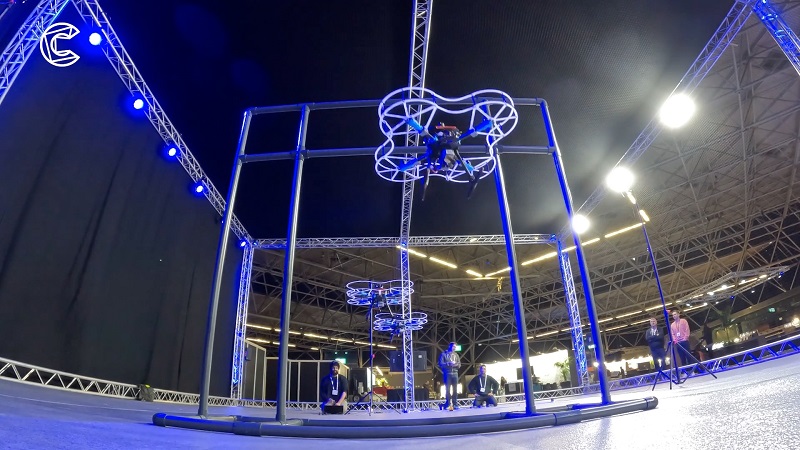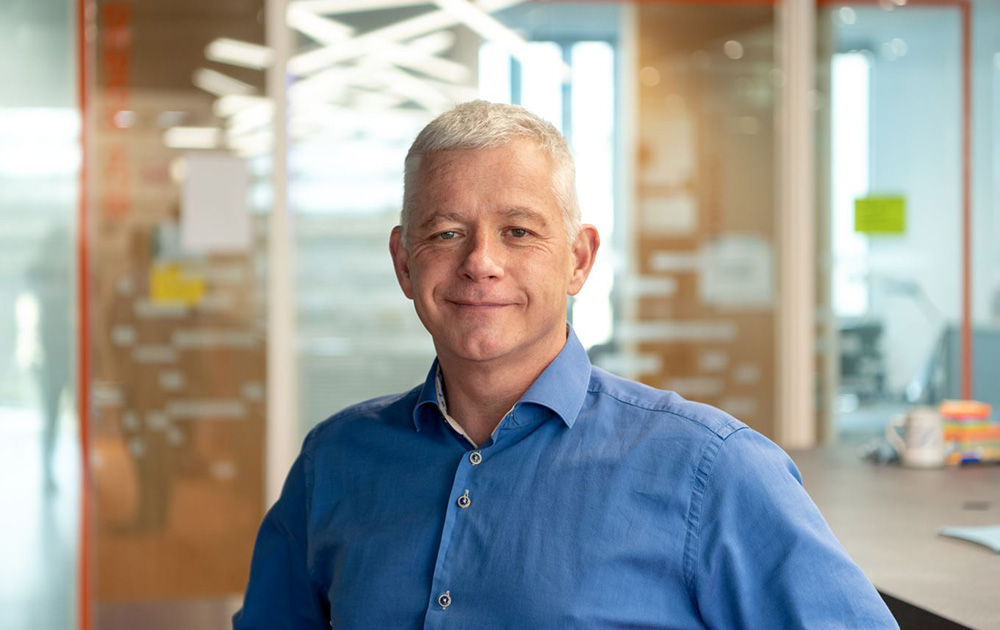The ability of machines to understand and interact with humans naturally has never been more paramount. But how does the human dimension apply to the future of drone programs, and what business value can this unlock?
Ahead of Commercial UAV Expo on Sep 5-7, we caught up with event chair, Martin Cookson to discuss these points and what he is most looking forward to throughout the event.
At Cambridge Consultants, Martin and his colleagues offer strategic advisory and technology development services for clients around the world. Many clients employ Cambridge Consultants for help in designing and deploying uncrewed ariel vehicles (UAV) control and Advanced Air Mobility (AAM) systems that extend beyond visual line of sight (BVLOS).
Commercial UAV News: What can you tell us about the work Cambridge Consultants has done to help your clients turn business opportunities into commercial successes, both in a general sense and specifically with drone technology?
Martin Cookson: Cambridge Consultants, or CC, is trusted by the ambitious to guide and realise their most critical technology-based aspirations through deep tech innovation. Typically, we work with two types of the client – those who need help to realise their vision for a revolutionary product or service, or those that looking to solve a highly complex engineering challenge. Achieving commercial success commonly involves delivering defendable innovation, being able to protect the innovation through the right choice of technology breakthroughs and patents, like putting a “moat” around their business. We have done that for many clients, including Flylogix who deliver full-service, over-horizon drone operations for offshore emissions measurement, without the cost and environmental impact of crewed aviation.
For companies setting out with a new product offering, we deploy thinking around what is desirable, viable and feasible for the solution – DVF. This ensures there is sound commercial basis to the plans from the offset. In drone technology, there are lots of organisations working in the very important sector of UTM and we have been helping businesses to choose the right path in this space.
Innovations with AI are set to transform the way many businesses operate, but what are some of the key signals you're looking for around how and when these transformations are taking place? Do you envision they'
There are at least two areas where we see innovation in AI being used with drones. Firstly, there is using AI to help autonomous flight – this is critical to change the commercial basis for drones to at least move to pilots-on-the-loop. Many of the algorithms are shared across industries and applications of autonomous agents and are not limited to arial vehicles. Object avoidance and location finding AI algorithms are shared with ground and marine based autonomous systems. The use of AI in drones is a subject I explore in more depth in a paper I have just co-written called “Collaborative autonomous drone fleets for next-level UAS operations”.

A critical aspect for UAVs is the important aviation regulations and the need to make flight safe. For that we need to include AI Assurance, to ensure we build in the safeguards and transparency for how AI algorithms are trained and operated.
The second area is using AI to obtain insights and value from the data that is collected from the proliferation of sensors that can be carried by drones. This is again shared across all industries. The uniqueness for drones is the accessibility they provide to obtain data for AI inspection that cannot be obtained in any other way.
In general, AI is quite application agnostic. The AI community actively tries to take technology developments in one area and apply them to the other. This is a good thing since the UAS industry does not have to develop its own proprietary and costly AI systems.
How have drones changed expectations across the enterprise when it comes to tasks that can be performed in faster, cheaper, and safer ways that have changed the way certain businesses operate? Given the larger transformations we just talked about, are some of these changes just the first step in this process?
I think we are still in process of changing expectations. Lots of organisations can see potential but turning these into effective commercial solutions is ongoing. It’s about thinking through all the details and approaching this in a safe and regulatory compliant way. However, there are some stand out markets where it is taking place – notably defense and security, infrastructure inspections and indoor applications.
Let’s look at infrastructure inspections. The recent world challenges have shown the fragility of supply chains and our dependency on energy infrastructure. Using drones to conduct safer and more effective inspections to ensure infrastructure resilience is a vitally important area. We do not want people doing dangerous jobs. We can also lift the value of human work by drones doing dangerous and unsavoury jobs, but doing this to augment human endeavours (part of the newly emerging Industry 5.0).
AI is an important step to achieving this, but industries need to come together to ensure the UTM infrastructure and communication capabilities are in place to support safe drone flight. This collaboration is critical for the large-scale civilian and enterprise applications that go beyond the early markets.
Your keynote at Commercial UAV Expo will fully explore many of these changes and transformations, with a specific focus on connecting breakthrough technology with the human dimension for drone programs of all sizes. What can you tell us about this human dimension and the ways in which it can create challenges and opportunities for organizations of all types?
With regard to humans, we can think of three groups that UAVs impinge upon. Firstly, we have those involved in missions. The key phrase here is augmentation. It's getting drones to do the jobs that are dangerous or inaccessible to humans and undertaking them quicker, more accurately or just taking the repetitive nature out of a task. Hopefully, this will be about increasing the value of human work. So that we use the human skills in analysis, critical decision making and empathy to use the data they provide. It means that the key challenge is how to orchestrate the overall mission process between the humans and drones.
The second group is pilots, which under the level of autonomy will be moving more to a pilot-on-the-loop. As they are controlling drones in BVLOS then they need to have the skills to operate remotely. They need to be assisted in situational awareness and have trust in the instrument and sensed data they are fed with. They need to have the connectivity and sensing to ensure drones are under control. As autonomy grows and the ratio of drones and fleets of drones to pilots increases, we will need to ensure the assisting systems have the right level of assurance to ensure pilots have the confidence to take on the responsibility.
The third group is the general public and the people the UAVs have direct contact with. As we know drones can be seen as quite sinister with questions on how they might impinge on people’s privacy or safety. Regulations are establishing a standard for an overall framework but there is more work to be done to better understand how drones distinguish between inanimate objects as compared to humans who have misconceptions, fears and are inquisitive. Giving a wider berth and having visual means to signal their intent could well be an advantage in civilian applications.
When it comes to applying drone applications that measurably improve performance and safety, what does it mean to accurately measure those differences in a way that goes beyond the bottom line?
Achieving safety is an absolute and this should not be driven by a commercial case – we must think safety first. However, one of the major costs will be obtaining the safety case to get aviation approval. Having a strong safety approach, supported by the right UTM infrastructure, along with using AI autonomy to make it safer, would deliver a competitive advantage.
There are so many performance parameters in flight that can be optimized. These include ground operations, weight and power, connectivity, battery life, coping with environmental conditions, and efficient traffic management. There is a huge opportunity for those operators that can put this overall system together.
We are already seeing specialist providers that optimize aspects of the system e.g., sky ports, USS, drone docking stations etc. Integrating these elements into a smooth operation is critical for the bottom line. The alternative we might see in certain industries is completely vertically integrated solutions – the obvious case is in the military.
What's one thing you want people to know about how they should consider taking their next step with drone technology in the near term, regardless of whether that means getting started with the technology or scaling efficiencies across their entire organization?
For me this is clear, its ‘data’ into ‘value’. UAS provide an incredible data acquisition platform – they can get us to locations and situations not possible in any other means and we can do this at incredible scale.
In some ways, the UAS dissolves and we can think how we unlock the value from that data. It could be building user convenience services, changing the way we work in dangerous industries or providing the data and insights to build new platforms, such as digital twins and industrial metaverses. I really look forward to exploring these exciting opportunities with the ecosystem at Commercial UAV Expo. Please don’t hesitate to connect with me on LinkedIn if you want to meet at the event.
Learn more about the Commercial UAV Expo keynotes or explore the rest of the conference program.




.png.small.400x400.png)











Comments